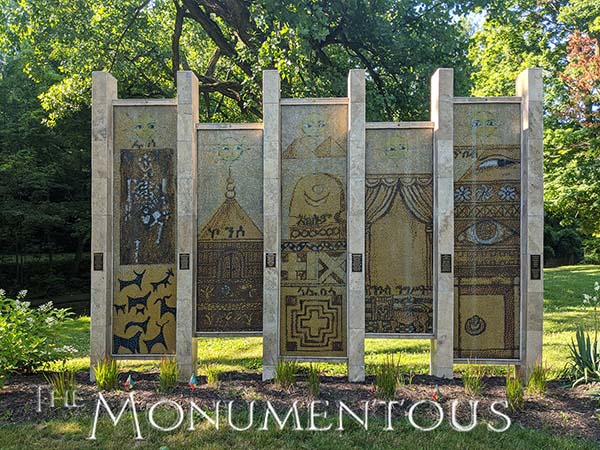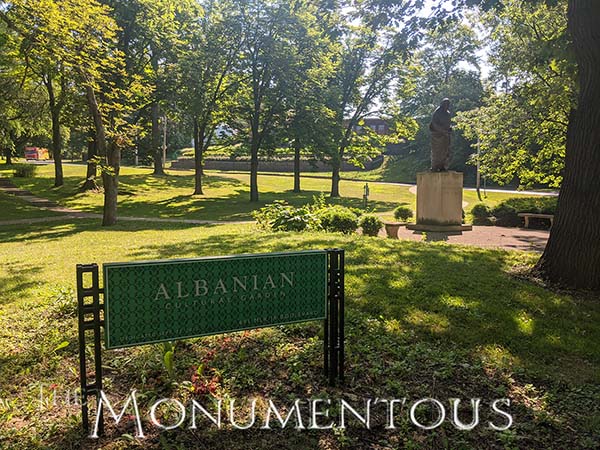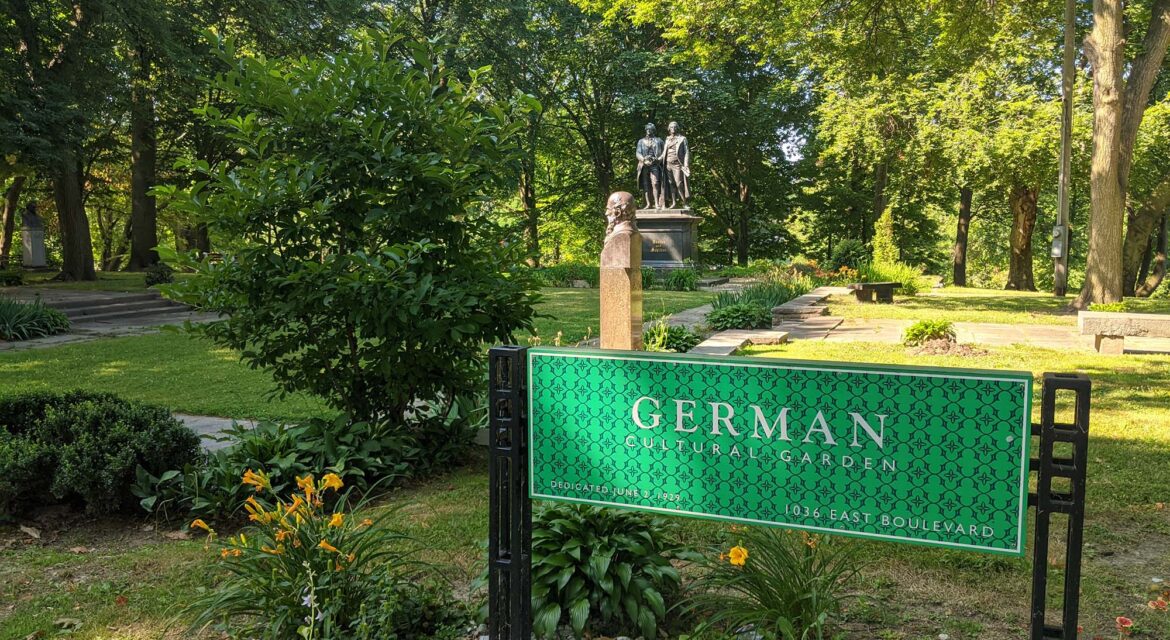 Rockefeller Park is home to the Cleveland Cultural Gardens, which are a series of independent but connected gardens that are all designed and cultivated by distinct cultural or nationality group. Located in Cleveland, Ohio, they represent the diversity and multiculturalism found across the city of Cleveland but do so in a way that enables connection and education across multiple groups, eras and cultures.
Rockefeller Park is home to the Cleveland Cultural Gardens, which are a series of independent but connected gardens that are all designed and cultivated by distinct cultural or nationality group. Located in Cleveland, Ohio, they represent the diversity and multiculturalism found across the city of Cleveland but do so in a way that enables connection and education across multiple groups, eras and cultures.
The Cleveland Cultural Gardens are at once a single and multi-faceted experience, as viewers can focus on the history and design of just one of the gardens or attempt to view them all. The gardens allow visitors to actively engage with these elements or more casually experience the serene sights and setting of the surrounding park. This imaginative use of space has come to serve as an incredible example of what it can mean to cultivate a community on a local and global scale to create untold benefits for everyone.

From a Shakespeare Garden to a Showcase of Culture
The origins of the Cultural Gardens go back to the creation of the Shakespeare Garden in Rockefeller Park that took place in 1916. Leo Weidenthal envisioned a garden chain that would represent the many cultures of the world and stand as a symbol of peace. That led to the Shakespeare Garden being renamed as the British Garden and the creation of the Hebrew Garden in 1926, which marked the official beginning of the Cleveland Cultural Gardens as they are known today.
 Cleveland’s immigrant population has had a major impact on which gardens were established over the decades. The German Garden was created in 1929 while the Italian Garden was established in 1930, both of which were a major part of the 30% of Cleveland’s immigrant population in the 1920s. The Slovak Garden, Slovenian Garden, Hungarian Garden and Irish Gardens were just a few that were added in the 1930s. The Greek Garden and Ukrainian Garden were established in 1940, with the Finnish Garden dedicated in 1958.
Cleveland’s immigrant population has had a major impact on which gardens were established over the decades. The German Garden was created in 1929 while the Italian Garden was established in 1930, both of which were a major part of the 30% of Cleveland’s immigrant population in the 1920s. The Slovak Garden, Slovenian Garden, Hungarian Garden and Irish Gardens were just a few that were added in the 1930s. The Greek Garden and Ukrainian Garden were established in 1940, with the Finnish Garden dedicated in 1958.
As the Cleveland population changed so did the focus on which gardens would be established. The Estonian Garden and the Romanian Garden were created in the 1960s, while the African-American Garden was the only garden to be established in the 1970s. The Chinese Garden that was created in 1985 would be the last one installed for twenty years. Since 2005, gardens like the Albanian Garden, the Turkish Garden and the Russian Garden have been established with much greater frequency and represent the makeup of Cleveland’s new immigrant populations.
These are just a handful of the cultures and national groups represented across the Cultural Gardens, each of which has a large display that calls out the cultural or nationality group that is being represented. Many more gardens are planned, which will further contribute to the more than 80 monuments and busts that express the cultural pride of each group in distinct ways. The history and culture that is an inherent part of each landscaped garden can be seen and experienced in multiple ways though.

Experiencing the Cultures of the World
The Cultural Gardens extend roughly 1.5 miles on streets that run parallel to one another, so a complete walk around the Gardens would be 3 miles in length. That layout has allowed many of the gardens to utilize multiple levels, all of which are sponsored and developed by the individual ethnic communities after which they’re named.
The Italian, Hebrew, Greek, Indian, Lithuanian, Hungarian, and German Gardens are among the largest, with the Lithuanian Garden featuring three distinct levels. Maps that showcase the layout of the entire site are displayed throughout the Cultural Gardens and also readily available.
 Dante Aligheri, Samuel Beckett, Frederic Chopin, Nicolas Copernicus, Yuri Gagarin, Mother Teresa and George Bernard Shaw are just a few of the notable people that are represented with a statue or bust in the Cleveland Cultural Gardens. The gardens feature other people that are not as well known and provide visitors with a much greater understanding and context of a cultural or nationality group. However, statues and busts are just a couple of the visual means of communication that are utilized to enable these insights.
Dante Aligheri, Samuel Beckett, Frederic Chopin, Nicolas Copernicus, Yuri Gagarin, Mother Teresa and George Bernard Shaw are just a few of the notable people that are represented with a statue or bust in the Cleveland Cultural Gardens. The gardens feature other people that are not as well known and provide visitors with a much greater understanding and context of a cultural or nationality group. However, statues and busts are just a couple of the visual means of communication that are utilized to enable these insights.
The abstract Flame Sculpture in the Estonian Garden is recognized as a symbol of freedom. The inscription on the monument is from Kalevipoeg, an epic Estonian poem. The Ethiopian Garden features a mosaic wall depicting aspects of the country’s history and culture. In the Syrian Garden, stone monuments that display a written history of Arab culture and a replica of the Arch of Palmyra are on display.
 Additionally, the Cleveland Cultural Gardens don’t adhere to country-specific representations. The African-American Garden was created to promote education and interest in African American culture and heritage as a whole. It conveys the past, present and future of the African American community via a series of design elements. The Rusin Garden celebrates an ethnic group that immigrated to Cleveland in the period from 1880 to World War I. They are an Eastern Slavic ethnic group who speak a dialect known as Rusyn or Lemko.
Additionally, the Cleveland Cultural Gardens don’t adhere to country-specific representations. The African-American Garden was created to promote education and interest in African American culture and heritage as a whole. It conveys the past, present and future of the African American community via a series of design elements. The Rusin Garden celebrates an ethnic group that immigrated to Cleveland in the period from 1880 to World War I. They are an Eastern Slavic ethnic group who speak a dialect known as Rusyn or Lemko.
Other notable features in some of the gardens include a series of brick and stone courts connected by paved walks in the Ukrainian Garden, the Alphabet Monument in the Armenian Garden, a 5-panel mural in the Ethiopian Garden and a Gettysburg Address Plaque in the American Garden. The recent addition of a statue of Pope John Paul in the Polish Garden highlights how many of these gardens are not static installations as they continue to grow and change.
This variety of education and history in every sense of the word has enabled audiences from all over the world to interact with the Cultural Gardens in whatever way they wish. Doing so is further supported by various initiatives and communal spaces that have been created.

Interacting with Culture and History
The Centennial Peace Plaza is a 300-seat amphitheater to be used for outdoor events. Created to celebrate the hundred year anniversary of the Cultural Gardens, it features a stage with a world map on its floor and a circular surrounding wall. The entranceway has a large pedestal with a peace medallion that features the Cultural Gardens’ mission statement: “peace through mutual understanding.” Multicultural music, dance and other educational and cultural offerings are scheduled in the plaza on a regular basis.
One World Day celebrations have been known to draw over 30,000 people to the area. The Parade of Flags where people in costumes of their heritage carry the flags is one of the most popular elements of the event.
 The Cleveland Cultural Gardens Federation also offers paid tours for the general public. By becoming a member of the Cleveland Cultural Gardens Federation, individuals and organizations can receive discounts on these prices along with various other benefits.
The Cleveland Cultural Gardens Federation also offers paid tours for the general public. By becoming a member of the Cleveland Cultural Gardens Federation, individuals and organizations can receive discounts on these prices along with various other benefits.
These events, as well as the monuments and landmarks contained in each garden, provide visitors with specific ways to experience the entire park, but it’s just as easy for both residents and tourists to casually stroll through the Cleveland Cultural Gardens on a bike or on foot. The stark differences in the weather from summer to winter to spring to fall make these experiences that much more distinct, allowing them to see a different side of the park practically every time they visit.
This variety is at the heart of what makes the Cultural Gardens such an endearing monument for visitors from across the city and world. It’s also why the legacy that the gardens represent and have cultivated will only become more important to viewers across the eras.

A Legacy for Cleveland and for Cultures Across the World
 It’s not hyperbole to say there is no other place in the world like the Cleveland Cultural Gardens. It is a major landmark in the city that attracts attention from across the world as evidenced by Albanian President Bujar Nishani attending the dedication of the Albanian Cultural Garden in 2012.
It’s not hyperbole to say there is no other place in the world like the Cleveland Cultural Gardens. It is a major landmark in the city that attracts attention from across the world as evidenced by Albanian President Bujar Nishani attending the dedication of the Albanian Cultural Garden in 2012.
With a collection of culturally significant monuments that appear nowhere else in the world along with a variety of ways to see and interact with them and the entire space, the Cleveland Cultural Gardens are an imaginative way to celebrate diversity and cooperation. They are one of the best examples in the world of what it means to utilize monuments and landmarks to create community and cultivate connections in a way that defines a legacy for a city and for entire cultures.

